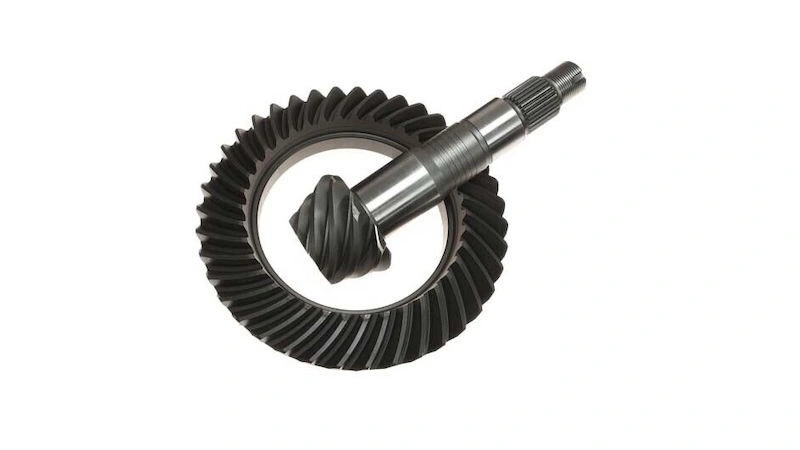When working on a car, truck, or any wheeled vehicle, truly understanding its differential gear ratio can make a major difference in performance, drivability, and component compatibility. Whether you’re repairing, upgrading, or diagnosing drivetrain issues, knowing how to find the differential gear ratio is a foundational skill. In this guide, I’ll walk you through clear methods, theory, practical tips, and common pitfalls—so you can find the correct ratio confidently.

Understanding Differential Gear Ratio
At its core, a gear ratio describes how many turns one gear (or shaft) must make to turn another gear once. In the context of a vehicle’s rear (or front) differential, the gear ratio typically refers to how many driveshaft or pinion turns produce one revolution of the axle (or wheel).
For example, if your differential ratio is 3.55:1, that means the driveshaft (or pinion) must spin 3.55 times for the wheels (or axle output) to turn once. A ratio of 4.10:1 is more aggressive—higher numeric ratio—meaning more torque multiplication but often lower top speed for a given engine RPM.
A lower (numerically) ratio, like 2.73:1, gives lower engine RPM at cruising speed but less torque at the wheels under load. Choosing or identifying the correct ratio depends on the vehicle’s purpose (daily driving, towing, off-road, performance, etc.).
Why Knowing Your Differential Ratio Matters
It’s not just academic. Here are key reasons why you’d want to know or verify the ratio:
- Performance & Acceleration: A higher (numerically) ratio gives stronger low-end torque, aiding acceleration or towing, at the expense of rpm at highway speeds.
- Fuel Efficiency & Cruise RPM: If your ratio is too aggressive, your engine may run at higher RPMs at cruising speeds, reducing fuel economy.
- Transmission Matching: Gear ratios must complement your transmission’s gears and torque curve.
- Speedometer & ECU Calibration: Many modern vehicles require calibration or adjustment when the differential ratio changes or when tire size changes, so that speed and odometer remain accurate.
- Part Replacement Compatibility: When sourcing replacement ring and pinion sets, housing, or axle assemblies, knowing the ratio ensures compatibility and avoids mismatches.
Because of these reasons, misidentifying or guessing the ratio is risky. Let’s go into the methods you can use.
Methods to Find Differential Gear Ratio
Here are the main practical approaches, from easiest to most involved:
Check the Identification Tag or Sticker
Many manufacturers apply a metal tag, label, or casting mark on the axle housing itself (typically on the differential cover, pumpkin, or housing body). This tag often includes:
- The axle model or designation
- The gear ratio (e.g. “3.73”, “4.10”)
- Sometimes other codes (manufacture date, production plant, etc.)
If you see a stamped or cast code like “37”, “47”, or “41”, it may correspond to 3.73, 4.70, or 4.10, depending on the manufacturer’s notation scheme. Always compare against a reference from that vehicle maker to interpret correctly.
Also check the vehicle’s door jamb, glove box, or service manual — some manufacturers include differential ratio information on build sheets or stickers inside the door frame.
- Pros: Easy, non-invasive
- Cons: Tags may be missing, painted over, or illegible; sometimes codes are cryptic
Use the VIN Number and Manufacturer Datasheets
In many cases, especially on newer vehicles, one can decode the VIN or use an OEM service parts database to find the original differential ratio used in that specific build. Steps:
- Retrieve the VIN (Vehicle Identification Number) — often found on the dashboard, driver’s door sill, or firewall.
- Use a VIN decoder or OEM parts catalog (often available online) and look up the axle / rear-end specification.
- Cross-reference with manufacturer documents (service manual, parts listings) to confirm.
This method works best when the vehicle has not been modified or had the differential swapped. It is more assured for newer or uncommon vehicles, less reliable for older ones or ones with aftermarket changes.
- Pros: Precise (if original), no disassembly
- Cons: Does not reveal modifications or swapped axles
Manual Counting Method (Physical Test)
This method is hands-on and works reliably if done carefully:
- Raise the vehicle: Safely jack up the vehicle and support it on jack stands so that both drive wheels are off the ground.
- Disable the parking brake and ensure the transmission is in neutral.
- Mark a reference on the driveshaft and mark the tire or wheel (for instance, chalk, paint, tape).
- Rotate the driveshaft: Turn the driveshaft (or pinion input) a fixed number of full turns (say, 10 revolutions).
- Count wheel revolutions: While rotating the driveshaft, count how many complete turns the wheel (or axle) makes in response.
- Compute ratio: Divide the number of driveshaft rotations by wheel rotations.
Example: If you spun the driveshaft 10 full turns, and the wheel turned 2.7 times, then the ratio is 10 ÷ 2.7 = 3.70:1.
Points to note:
- Be careful to count only full revolutions and avoid slippage.
- Use consistent speed and avoid jerky turning.
- Better to repeat several times and average.
Open the Differential Cover & Count Gears
This is the most direct and precise method if you’re willing to do mechanical disassembly (or have access to the ring + pinion set):
- Drain the differential fluid and remove the cover or housing.
- Inspect the ring gear: count the number of teeth on the ring gear.
- Inspect the pinion gear: count its number of teeth.
- Calculate ratio:
- Differential Ratio = Ring Gear Teeth / Pinion Gear Teeth
So if the ring gear has 41 teeth, and the pinion gear has 10 teeth, the ratio is 41 ÷ 10 = 4.10:1.
This method also reveals any internal modifications (e.g. aftermarket gears). However, care is needed — differential internals are delicate, must be cleaned, reassembled with proper torque settings and shims if disturbed.
- Pros: Highest precision, reveals internal condition
- Cons: Requires mechanical skill, takes time, risk of misassembly
Tip: If you want a faster way to calculate the differential ratio without manual math, our previous article includes a differential gear ratio calculator. You can simply input the number of teeth for the ring and pinion gears, and it will compute the ratio instantly. Check it out here: How to Choose the Right Gear Ratio
How to Identify Limited-Slip vs. Open Differential During Testing
While discovering the gear ratio, you might also want to know whether the differential is open or limited-slip (LSD). Here are a couple of simple tests:
- Wheel Spin Test: Lift one wheel—spin it by hand. In an open differential, the opposite wheel will spin in the opposite direction. In a limited-slip, the opposite wheel may also turn in the same direction or resist counter-motion.
- Load Test (with care): Under light torque (e.g. applying throttle in neutral), observe how the wheels respond. If both wheels try to pull, it’s likely LSD.
Knowing whether LSD is present matters because when changing to a different ratio, the friction or clutch packs inside the LSD must be compatible or recalibrated.
Common Gear Ratios & Their Applications
Here are a few typical differential ratios and where you might see them:
- 2.73:1 — often used in highway / fuel-efficiency setups (low RPM cruising)
- 3.23:1 — balanced for general use
- 3.55:1 — popular for light-duty trucks, daily drivers, moderate towing
- 3.73:1 — sporty setup, some performance or off-road builds
- 4.10:1, 4.56:1 — aggressive performance or heavy-duty towing / drag setups
When choosing a ratio, consider:
- Engine torque curve: A ratio too aggressive for a low-torque engine yields poor drivability.
- Tire size: Larger tires reduce effective ratio; a more aggressive differential may be needed to compensate.
- Transmission gearing: You don’t want to over-rev in top gear or run out of torque in low gear.
- Intended use: Towing, hauling, off-road, drag racing, daily commuting — each has different optimal trade-offs.
Tips Before Changing Your Gear Ratio
If you plan to upgrade or replace gear sets, keep these in mind:
- Confirm compatibility: Ensure that the new ring & pinion match your axle housing (carrier type, spline count, backlash, thickness).
- Calibrate speedometer / ECU: Many modern vehicles need ECU reprogramming when differential ratio changes, or speedometer will read incorrectly.
- Break-in procedure: New gears often require a run-in or break-in procedure (light loads at first, specified torque cycles).
- Check for clearance and alignment: Proper bearing preload, backlash, and gear mesh are critical.
- Upgrade supporting components: When using a more aggressive ratio, ensure the driveshaft, axles, u-joints, and other components are strong enough for increased torque loads.
Conclusion
Finding the differential gear ratio is not a mystery — it’s a matter of logic, care, and a mix of mechanical insight and methodical testing. You can start by looking for identification tags or decoding the VIN; if that fails or you want full certainty, the manual counting test or opening the differential gives you real, measurable data.
By understanding your vehicle’s ratio, you empower yourself to make smarter choices—whether upgrading, replacing parts, diagnosing issues, or simply matching components properly. Before any swap or change, always confirm ratio, understand the limits of your drivetrain, and follow safe mechanical practices.
If you ever need help selecting a correct ring-and-pinion set or matching an axle upgrade for your build, feel free to reach out. I’d be glad to help you pick the optimal ratio and parts to suit your performance goals.



